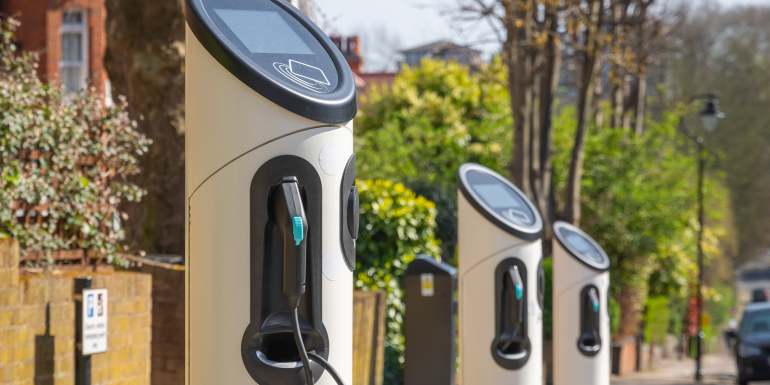Electric vehicle charging points – what you need to know

We speak to Sam Lott about his upcoming CABE Webinar that will look at the ever-developing world of electric vehicle charging provision and how Approved Document S now affects construction projects.
 To their supporters and enthusiasts, electric vehicles have the power to change the world, especially a world that is trying to achieve Net Zero. But with the publication of Approved Document S – ‘Infrastructure for the charging of electric vehicles’ – the requirements needed for electric vehicle charging points are changing the professional world of building engineers right now.
To their supporters and enthusiasts, electric vehicles have the power to change the world, especially a world that is trying to achieve Net Zero. But with the publication of Approved Document S – ‘Infrastructure for the charging of electric vehicles’ – the requirements needed for electric vehicle charging points are changing the professional world of building engineers right now.
To help navigate the new expectations around electric vehicle charging provisions, energy data consultant Sam Lott from energy software and data specialists Sava will be presenting a CABE Webinar Wednesday presentation in September. As a taster of what he’ll be delivering, we spoke to Sam about some of the reasons why this webinar is so needed.
Charging basics
“My webinar is titled ‘Plugging into the Future’ and it’s going to specifically focus on electric vehicle charge points and Part S. Parts S is a new building regulation that was brought in on 15 June 2022 and it was developed to try to ensure that the infrastructure for electric vehicle charge points is appropriately put in place now to future proof the UK,” Sam said.
“The general flow of the webinar will start with me talking about electric cars and why they are needed in the UK in order for us to hit the Net Zero goal by 2050. I will look at what the policy is at the moment regarding the shift over the next decade towards electrified Britain, and how electric cars are going to be at the forefront of solving the carbon output of the road transport sector.
“Then, because at Sava we work with a lot of social housing providers, I’ll look at Part S. I’ll talk about what Part S entails, who it affects, the different types of properties and buildings that are going to have to comply with Part S, and some of the exemptions and technical requirements within Part S itself.”
While Part S is a relatively new factor in the considerations around electric vehicle charging provision, electric vehicles are a firmly-established part of modern life. However, Sam said, a lot of the accepted wisdom around electric vehicles isn’t necessarily accurate.
“I think a common misconception about electric vehicles generally is that electric charging can be quite slow and quite expensive. Part S tries to combat this and allows everyone to have charge points as a standard part of their home electrical connections,” Sam said.
“Technically, the new requirements are that all charge points must have a minimum 7kW output, which allows the majority of electric cars to charge to full, more or less, in about six to eight hours. The idea is that you can plug a car in overnight just like you do your phone, and by the time you wake up, your car will be charged.
“This approach tries to alleviate the concerns a lot of people have with the ability to charge. By having more charge points around, it also obviously helps to reduce the range anxiety that some electric car users have. One of the biggest barriers that people have when choosing electric cars at the moment is range anxiety. The whole idea of these Part S regulations is that new build homes will be required to include electric car charge points, thus ensuring the infrastructure for electric vehicles is adequately put in place.
Electric futures
The future use of electric vehicles, Sam said, goes beyond just being a means of transport. As part of a fully integrated electric grid, they may play a vital role in keeping our energy system healthy on a wider level.
“Electric vehicles are going to play a massive role in the electrification of Britain in general. Everything is moving towards an electrified Britain, not just vehicles but when the New Future Homes Standard is brought in in 2025, space heating demands are likely to be electrified with air source heat pumps, etc. This is going to increase demand on the grid,” Sam said.
“But with vehicle-to-grid technology, homes will be able to have their electric cars plugged into the mains and the car’s own battery can feed back to the grid at times of peak demand, which can help reduce the burden on the grid.
“The most expensive way to increase grid capacity is to reinforce the grid itself, but electric vehicles could be part of the solution to this; they can provide meaningful amounts of power that can be fed back into the grid. These kinds of things are being developed right now and are realistically going to be one of many solutions to a lot of problems that will spark up in the coming years.”
While the majority of Sam’s webinar will outline the electric vehicle charging provisions that building engineers have to install now and in the immediate future, he will also look a little further ahead to innovations on the horizon.
“One thing that really interests me is the concept of e-lanes, which have been talked about in the UK recently. The general idea behind them is that, whilst you drive your electric car, you’d actually be able to charge it at the same time, which will significantly help overcome people’s ideas of range anxiety and help to extend the range even further," Sam said.
“These e-lanes might also include the exciting technology of wireless electric car charging. This has been trialled in the US and there is speculation that that could be a massive market in the future. So I’ll have a few slides where I will be focusing on speculative technology in the electric car industry.
“Electric cars are going to be the future of every driver’s day-to-day life. But more specifically, if you are a house builder or you work in construction, this will become part of everybody’s thinking when it comes to building new homes, and you are going to have to know what the policies are regarding all of this. The webinar will go into all of these details in a way that is – hopefully – more entertaining than just reading through the Part S document!”
Sam’s Webinar ‘Plugging in to the future – Electric vehicle charging and Part S’ will take place at 10am on 13 September 2023. Click here to register.
And if you do want to read Approved Document S ‘Infrastructure for the charging of electric vehicles’, it can be found here.








